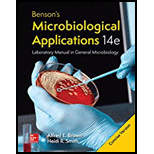
Concept explainers
To explain: The reason why
Introduction: Bacteria are unicellular prokaryotic organisms that maintain a definite shape since they contain the rigid cell wall. They are classified into different types based on the structure, namely coccus (spherical shaped), Bacillus (rod-shaped), filamentous, spirilla (spiral-shaped), appendaged, and pleomorphic bacteria. The structure of bacteria can be viewed under the microscope using the staining methods.
Explanation of Solution
Gram staining is an example of differential staining. It is based on the principle that the cell or structures within the bacterial cells display dissimilar reactions with the staining procedure. Based on this staining procedure, the bacterial cells are classified as Gram-positive and Gram-negative bacteria. Gram-positive bacteria contain thick peptidoglycan layer, whereas Gram-negative bacteria contain thin peptidoglycan layer. Thus, staining with crystal violet is retained in Gram-positive bacteria even after treating with alcohol solution, whereas Gram-negative bacteria decolourize and take the counterstain safranin. Thus, Gram staining is considered as differential stain where Gram-positive bacteria appear as violet color and Gram-negative bacteria appear as pink color.
Want to see more full solutions like this?
Chapter 14 Solutions
LooseLeaf Benson's Microbiological Applications Laboratory Manual-Concise Version
 Human Anatomy & Physiology (11th Edition)BiologyISBN:9780134580999Author:Elaine N. Marieb, Katja N. HoehnPublisher:PEARSON
Human Anatomy & Physiology (11th Edition)BiologyISBN:9780134580999Author:Elaine N. Marieb, Katja N. HoehnPublisher:PEARSON Biology 2eBiologyISBN:9781947172517Author:Matthew Douglas, Jung Choi, Mary Ann ClarkPublisher:OpenStax
Biology 2eBiologyISBN:9781947172517Author:Matthew Douglas, Jung Choi, Mary Ann ClarkPublisher:OpenStax Anatomy & PhysiologyBiologyISBN:9781259398629Author:McKinley, Michael P., O'loughlin, Valerie Dean, Bidle, Theresa StouterPublisher:Mcgraw Hill Education,
Anatomy & PhysiologyBiologyISBN:9781259398629Author:McKinley, Michael P., O'loughlin, Valerie Dean, Bidle, Theresa StouterPublisher:Mcgraw Hill Education, Molecular Biology of the Cell (Sixth Edition)BiologyISBN:9780815344322Author:Bruce Alberts, Alexander D. Johnson, Julian Lewis, David Morgan, Martin Raff, Keith Roberts, Peter WalterPublisher:W. W. Norton & Company
Molecular Biology of the Cell (Sixth Edition)BiologyISBN:9780815344322Author:Bruce Alberts, Alexander D. Johnson, Julian Lewis, David Morgan, Martin Raff, Keith Roberts, Peter WalterPublisher:W. W. Norton & Company Laboratory Manual For Human Anatomy & PhysiologyBiologyISBN:9781260159363Author:Martin, Terry R., Prentice-craver, CynthiaPublisher:McGraw-Hill Publishing Co.
Laboratory Manual For Human Anatomy & PhysiologyBiologyISBN:9781260159363Author:Martin, Terry R., Prentice-craver, CynthiaPublisher:McGraw-Hill Publishing Co. Inquiry Into Life (16th Edition)BiologyISBN:9781260231700Author:Sylvia S. Mader, Michael WindelspechtPublisher:McGraw Hill Education
Inquiry Into Life (16th Edition)BiologyISBN:9781260231700Author:Sylvia S. Mader, Michael WindelspechtPublisher:McGraw Hill Education





